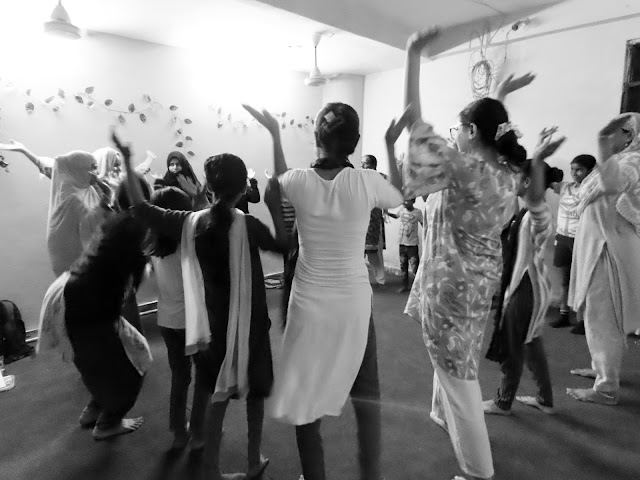Recently, I spent five days in Lucknow two of which were taken up with travel and sightseeing. The other three, I spent at Mamta Varma’s atelier in the heart of Chowk. Buzzing with life on the outside, the inner sanctum was imbued with her quiet spirit and resilience. The work she creates is outstanding. They’re precious evocations of an ancient art. When you see the fineness of Bhairavi’s Chikankari, nothing else matches up. I couldn’t afford those luxury prices but I was happy to see someone making hand crafting a luxury.
On the way to Lucknow Junction Station, to catch our train back to Delhi, we had some time to kill and went to Hazratganj market to check out what else the market had to offer. Shalini couldn’t bring herself to buy the coarser version of chikan at otter high end chikankari shops. Threads sticking out at the back. Embroidery that wasn’t done with love and passion but for rozi.
What I’d managed after just three days of learning actually seemed better than the chikankari we had seen. I couldn’t believe that the ends hadn’t been worked into the embroidery as Nasreen had diligently imposed upon us during our training sessions. She was particular about the direction of the needle, the direction of the frame, the tension of fabric and thread. The number of strands needed for which kind of stitch and more. Things that cannot be spelt out but must be observed.
She shared stories of how she came to learn chikankari. Where her teacher, designated by the government to impart the skill to women, wouldn’t teach her everything she wanted to learn. Determined as she was, she found a way around it. Her teacher had lice. Under the guise of looking for them in her hair, standing behind the woman, Nasreen had a great vantage point to study the then forbidden jaali stitches - her speciality today.
Seated on the floor, each taking a backrest against the wall or steel almirahs, eyes cast on the tiny frame covered with stitched together scraps of fabric for a grip to hold and stretch the fabric to be embroidered. Fingers nimble, manipulated needle and thread with an easy dexterity. Just looking you’d think it was simple enough. But, sitting amongst them, I felt almost foolish to imagine I could actually learn enough.
Perhaps, I didn’t master any of them. Maybe I can’t learn the entire repertoire of 32 stitches. But, what I did learn was that chikankari is not just about a stitch or even 32, it’s the art of deciding which stitch will go where. Bakhiya with hatkati, with ghas patti, bijli, phanda, tepchi-pechni and jaali, but it’s the configuration of these stitches that really creates the masterpiece. As also the skill of working with them.
I also had the privilege of seeing Mamta and Paola work together with the block printer Aleem. Watching the meticulous, patient decision making of what block to place where. Some blocks were no more than 3/4”. The block printers chaapon the fabric with Neel. The blocks for chikankari are different to the blocks for printing fabric. They’re designed to keep space for the jaali and bakhiya, in as much as space for hathkati amid the printed lines. In many ways watching the process unfold was like observing fabric being woven. You’re never quite sure when threads floating mid air through heddles become the fabric on the loom. The women create their magic by consensus among themselves with Mamta, Paola and others and each piece is a labour of love.
Squatting on the floor chowkri-maar, albeit awkwardly because one knee isn’t as strong as the other, pouring over the frame, focussed upon Nasreen’s fingers as she manipulated needle, thread and fabric. I felt a deep sense of camaraderie with these women. It was as if they were my tribe. They understood my calloused fingers, they relished my tools, loved them as I do. They understood the song of needle pulling thread. And, like me, they experienced the sukoon of repeated movements of stitch. They knew the discipline of battling knots. They knew the impact of needle and thread on their psyche. But, above all, they were grateful to leave their burkhas on the wall hooks and be free among their brethren. Koi kisi ki naani, koi cousin, some betrothed waiting to be married. Some with families and spouses they loved and wished to have for seven lifetimes. Others abused, divorced and single mothers. There were stories in each pair of eyes. And that was all one saw when they left for the day when burkhas and hijabs covering everything else.



















